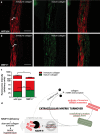Aberrant Collagen Composition of the Trabecular Meshwork Results in Reduced Aqueous Humor Drainage and Elevated IOP in MMP-9 Null Mice
- PMID: 27820954
- PMCID: PMC5102567
- DOI: 10.1167/iovs.16-19734
Aberrant Collagen Composition of the Trabecular Meshwork Results in Reduced Aqueous Humor Drainage and Elevated IOP in MMP-9 Null Mice
Abstract
Purpose: Homeostatic turnover of the trabecular meshwork extracellular matrix (ECM) is essential to regulate aqueous humor outflow and to maintain intraocular pressure homeostasis. In this study, we evaluated aqueous humor turnover, intraocular pressure, and trabecular meshwork organization in MMP-9 null mice.
Methods: Intraocular pressure and aqueous humor turnover were measured in MMP-9 null versus wild-type mice. Morphology of the anterior segment of the eye, with special attention to the structural organization of the trabecular meshwork, was investigated by means of optical coherence tomography, light microscopy, and transmission electron microscopy. Furthermore, using quantitative real-time polymerase chain reaction and immunostainings, we evaluated the ECM composition of the trabecular meshwork. Finally, the integrity and function of the retina and optic nerve were assessed, via optical coherence tomography, histologic techniques, and optomotor testing.
Results: MMP-9 null mice displayed early-onset ocular hypertension and reduced aqueous humor turnover. While transmission electron microscopic analysis did not reveal any abnormalities in the cellular organization of the trabecular meshwork, detailed investigation of collagen expression indicated that there is an aberrant trabecular meshwork ECM composition in MMP-9 null mice. Notably, at the age of 13 months, no glaucomatous neurodegeneration was seen in MMP-9 null mice.
Conclusions: Our observations corroborate MMP-9 as an important remodeler of the collagenous composition of the trabecular meshwork and provide evidence for a causal link between MMP-9 deficiency, trabecular meshwork ultrastructure, and ocular hypertension.
Figures






References
-
- Quigley HA. Glaucoma. The Lancet. 2011; 377: 1367–1377. - PubMed
-
- Bradley JM,, Kelley MJ,, Rose A,, Acott TS. Signaling pathways used in trabecular matrix metalloproteinase response to mechanical stretch. Invest Ophthalmol Vis Sci. 2003; 44: 5174–5181. - PubMed
-
- Bradley JM,, Kelley MJ,, Zhu X,, Anderssohn AM,, Alexander JP,, Acott TS. Effects of mechanical stretching on trabecular matrix metalloproteinases. Invest Ophthalmol Vis Sci. 2001; 42: 1505–1513. - PubMed
-
- Kelley MJ,, Rose AY,, Song K,, et al. Synergism of TNF and IL-1 in the induction of matrix metalloproteinase-3 in trabecular meshwork. Invest Ophthalmol Vis Sci. 2007; 48: 2634–2643. - PubMed
MeSH terms
Substances
Grants and funding
LinkOut - more resources
Full Text Sources
Other Literature Sources
Molecular Biology Databases
Miscellaneous

